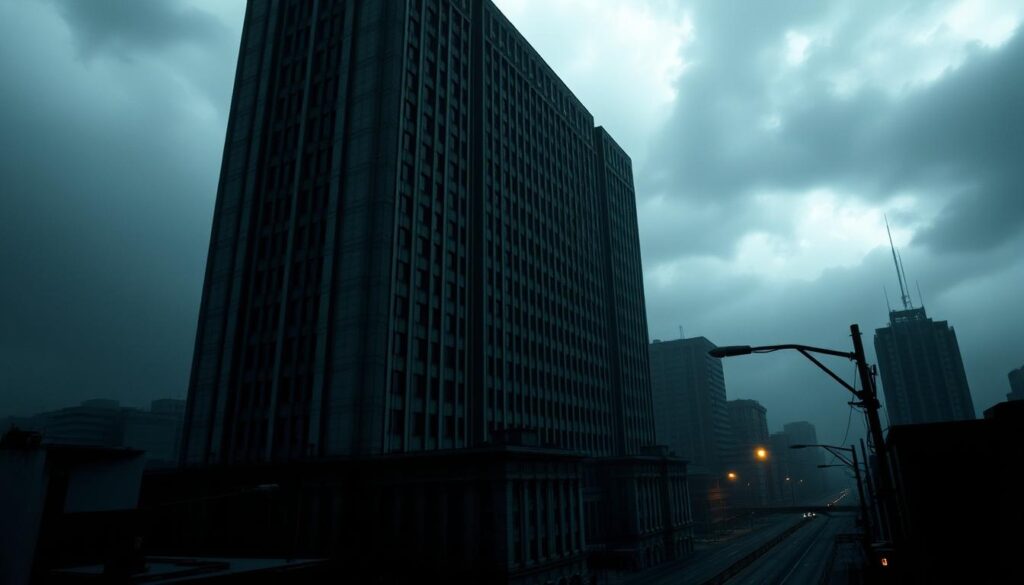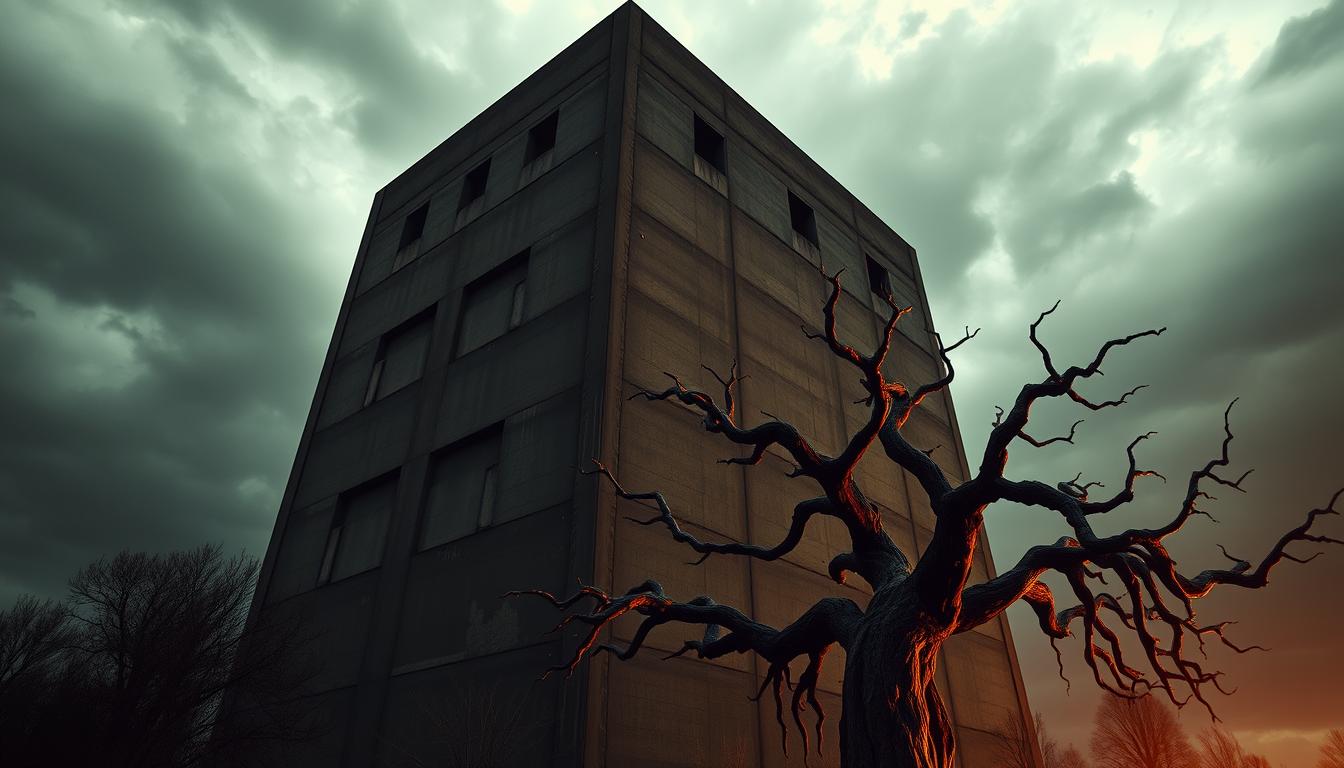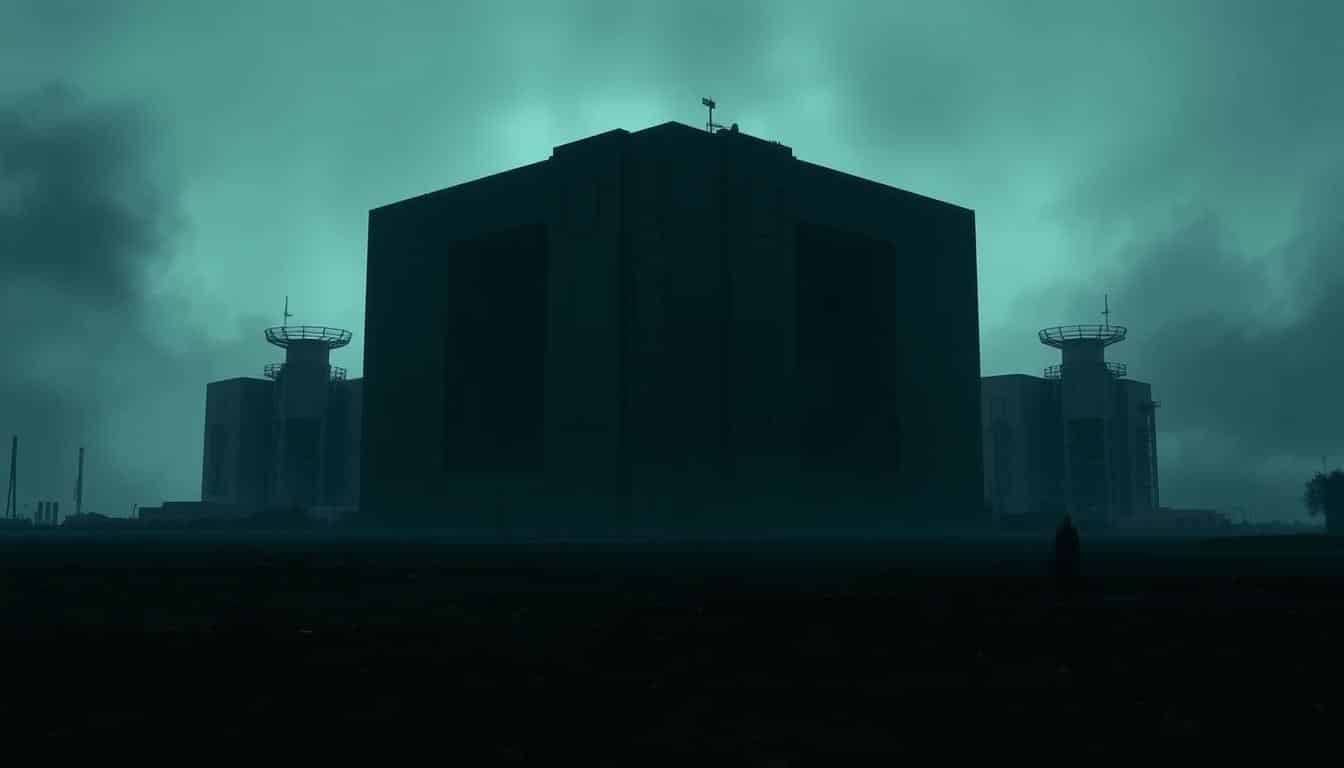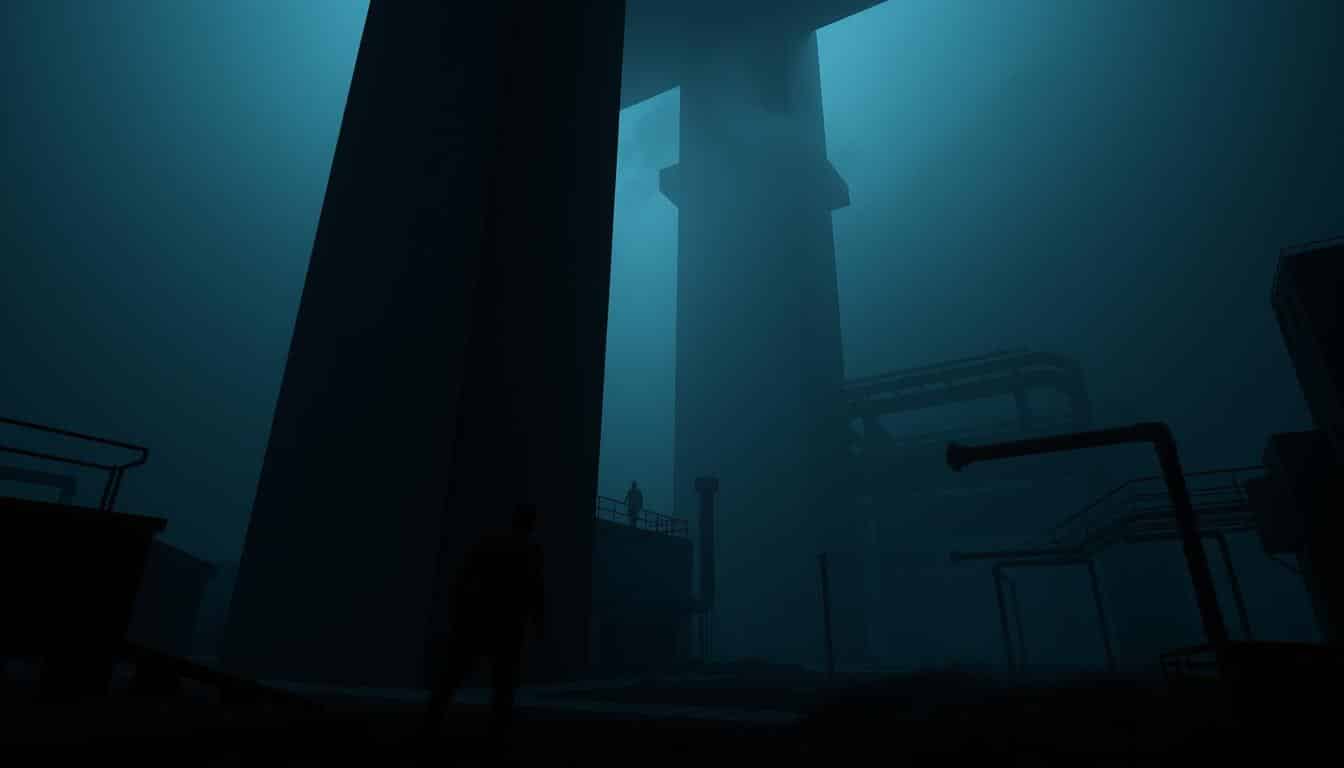Horror and brutalism share a special connection, as the cold, hard lines of certain buildings match our feelings of fear. We’ll look into how brutalism’s distinct style makes dread even deeper, especially in horror stories. By digging into this relationship, we’ll see how architectural horror’s dark themes can make us feel more scared.
The Intersection of Horror and Architecture
Architecture can make us feel different emotions. Horror architecture is a perfect example. It shows how buildings and our feelings connect, creating a special way to explore scary designs. Places built with certain ideas, especially those in the brutalist style, can make us feel uneasy and scared. The fear comes from things like sharp angles, heavy materials, and strong shadows.
Famous architects like Le Corbusier and Louis Kahn show that careful design can make a place feel spooky. Their big, imposing buildings are both amazing and a bit creepy. Looking at these famous places, we see how they change our experience. They remind us of scary stories and movies. The buildings become like characters, adding to the feeling of fear.
Our feelings are affected by our surroundings. So, understanding how scary architecture and horror stories connect is important. This helps us see how building design can tell a story. It makes scary parts of a story stronger and pulls us into the tale.

Brutalism: A Stark and Eerie Aesthetic
Brutalist architecture grabs attention with its raw shapes and tough surfaces. It’s known for a stark look that often makes people feel uneasy. These big concrete buildings tower over places, making you feel alone, which fits right into scary stories.
Eerie buildings bring a sense of tension and fear. Their big size can make normal places feel scary, adding depth to stories and movies. Brutalist architecture’s design mirrors the mess inside horror, showing the stress and fear people feel.
These amazing buildings change how we see safety and comfort in cities. Brutalist architecture’s role in telling scary stories is huge. It helps dig into deep fears and themes, making it vital for horror.
Historical Context of Horror in Literature
Horror literature has a rich history that shapes it today. It started with gothic fiction. Stories were about darkness and the unknown. Edgar Allan Poe and Mary Shelley made stories that scared and fascinated people.
Early Influences and Iconic Works
Horror stories began by mixing mind tricks with the supernatural. Poe and Shelley led the way. Their tales, like “Frankenstein” and “The Tell-Tale Heart,” showed loneliness and insanity.
- Edgar Allan Poe: Mastery of psychological terror.
- Mary Shelley: Birth of the science fiction horror hybrid.
- MR James: Innovator of ghost stories that humanize the supernatural.
- HP Lovecraft: Creator of cosmic horror, exploring dread in isolation.
The Evolution of Horror Themes
Horror themes changed over time. They went from gothic frights to feeling scared of what exists. Writers began to tie in big social issues. Now, horror talks about a lot of different fears. It makes us think and feel deeply. Stories today deal with everything from trauma to finding out who we are.
Unearthing Psychological Horror
Psychological horror dives deep into our minds. It shows how our own fears can scare us more than external threats. This genre focuses on deep fears, often tied to identity crises, trauma, and loneliness.
When we watch these stories, we face our own fears too. This makes the experience even more intense and personal.
Modern horror stories use these ideas well. They show characters dealing with mental struggles, not just monsters. Recent movies use creepy storytelling to make us feel scared and vulnerable.
These movies often mix reality and imagination, making everything feel uncertain and eerie.
Horror movies that explore psychology give us insights into our emotions. They show how personal traumas can turn into terrifying stories. These stories stay with us long after the movie ends.
When we see these movies, we start to deal with our own fears. We learn that sometimes, the scariest things come from inside us.
horror and brutalism: A Symbiotic Relationship
The link between brutalism and horror is a unique mix of art and feeling. Buildings that invoke fear often have stark lines and heavy materials, making you uneasy. These traits make such places ideal for horror, as they touch on our basic fears and mental responses.
Architectural Elements that Evoke Fear
Brutalist designs have elements that can really scare people. They feature:
- Enclosed spaces that make you feel trapped.
- Monochromatic surfaces that strip away any sense of coziness.
- Jagged shapes that break from what we’re used to, making us nervous.
These design choices are key in creating a scary architecture. They build up tension and expectation, like in horror stories where places seem alive.
Symbolism in Brutalist Structures
Architecture carries deep symbolic meanings. Brutalist buildings often show how society is breaking down, reflecting our despair and loneliness. This symbolism ties to horror’s psychological sides, where settings echo the characters’ inner conflicts. The simplicity and starkness of brutalism highlight horror themes, forcing us to think and feel uneasy.
The Role of Setting in Horror Narratives
The setting in horror stories really matters. It creates a spooky atmosphere that makes us feel scared and tense. Places like old buildings, foggy woods, and broken-down cities add to the creepiness. The way these places look and feel is key. It changes how we see the story and feel about the scares that come next.
Adding creepy details makes horror even more real. Think about a scary, old house with squeaky floors and shadowy corners. It makes us anxious and excited to see what happens. Open, empty spaces can make us feel alone and scared, too. Horror settings do more than just look scary. They make us feel part of the story and stir up deep feelings.
Horror settings play with our feelings, taking us on an emotional ride. The look and feel of places, like dark buildings or shadows, blend with the story. This makes the horror stick with us even after the story ends. It shows just how important setting is in making a horror story hit deep and stay memorable.
Modern Horror Films Inspired by Brutalist Design
Modern horror movies often use brutalism, blending sharp architecture with horror elements. This mix helps tell the story, creating a place where fear lives. Brutalist design features like bare concrete and shapes make the movie’s tension stronger.
Case Studies of Key Films
Some films stand out for their use of brutalist architecture to tell a story and bring out fear:
- Candyman: Uses Chicago’s daunting buildings to show loneliness and terror.
- High-Rise: Shows a dystopian world, where the buildings add to the breakdown of social rules.
- The Platform: The setting is tight and grim, blending architecture with horror, showing struggle and survival.
How Brutalism Shapes Cinematic Experiences
Brutalist architecture deeply changes how we experience horror movies. Its raw look not only makes settings eerie but also connects with the characters’ fears. These massive buildings make people feel trapped and scared, making the space around them a key part of the fear.
The visual style of horror movies today often includes:
- Contrast between light and dark to show off the buildings.
- Tight spaces that make the emotional scenes stronger.
- Architecture that helps tell the story and build up what will happen next.
The Cultural Impact of Horror and Brutalism
The mix of horror and brutalism has a big effect on culture and art. These elements often show and grow the fears of a community. Brutalism’s bold shapes and raw materials set the scene for haunting stories. This setting is key in movies, books, and art.
Art mixed with horror comments on how we see terror. It goes beyond limits and questions the usual. This mix makes us feel everything from fear to curiosity. It makes us face deep questions about life. Brutalism’s style offers a meaningful place for this. Its architecture acts as a silent part of the story. It shows our fears and discomfort.
Horror keeps changing and growing with brutalist styles. It shows a society facing big upheavals. Art reflects our personal and shared scares. This interaction not only holds our attention but also makes us think deeply about our lives.
Exploring the “Pleasure Shiver” Phenomenon
The pleasure shiver is the thrill we get from feeling scared. It shows up a lot in scary books and movies. People like these scary stories because they’re curious about life’s dark sides. This mix of fear and curiosity pulls them toward these tales.
Psychologists think this thrill comes from wanting a rush and to let emotions out. They see it in scary but cool-looking buildings too. These feelings, mixed with creepy places, make our fear more intense but exciting.
When we face our fears in movies or books, it’s both scary and fun. This mix makes horror a big part of culture. Horror’s effects stick with us, making us come back for more.
Art Exhibitions Merging Horror and Brutalism
The mix of horror and brutalism in art is fascinating and seen in many modern shows. Artists use the bare, straightforward look of brutalism to make horror art. This art makes people feel strong emotions. These shows make us face our fears while we’re pulled into the experience by light and shadows.
There are important shows that mix horror and architecture, showcasing many kinds of artworks. You’ll see everything from spooky setups to strange sculptures. The art blurs the line between beauty and fear, pulling people into a scary world made by the artists.
- Exploration of space often mirrors psychological fears.
- Installation pieces that challenge perceptions of safety.
- Innovative uses of materials that amplify eerie atmospheres.
Shows digging into horror also talk about our society and our personal fears. This makes horror art a powerful way to share ideas. The use of brutalism gives a unique backdrop to these creepy stories. This ensures visitors are both captivated and disturbed.
Responses to Horror: Audience Preferences
How people react to horror really depends on who they are, especially when it comes to gender. These differences help those who make movies and shows know what kinds of stories different people like. Studies have found that women usually like horror that’s more about the mind and feelings, not so much blood and guts. They enjoy stories that make you think and feel scared without showing too much.
The Gendered Aesthetic of Horror
Looking into how gender affects what kind of horror people like can really help creators. By knowing this, filmmakers and authors can better appeal to their audience. Here’s what they’ve found:
- Women are drawn to stories that build suspense and play with their minds. They respond more to the emotional side of horror.
- Men are more into horror that shows a lot of action and graphic scenes. They like the thrill of being scared this way.
- It seems that female viewers enjoy movies that also talk about community and relationships, making the horror feel deeper.
- The way horror is seen can change depending on gender, making some stories scarier or more emotional for different viewers.
Conclusion
The study of horror and architecture shows a deep link that echoes in our culture. It’s more than just looking at buildings. It’s about understanding how they make us feel inside. Brutalism, with its bold look, brings out strong feelings and makes horror stories even more powerful.
Architecture plays a huge role in making stories feel real and scary. Spaces can make fear and tension grow. Using brutalism in modern horror helps connect with audiences in a special way. This approach lets us see horror and architecture in a new light.
There’s a lot more to explore in this area. By digging deeper into these themes, we can learn how design shapes stories and grabs our attention. This journey into the eerie blend of horror and architecture is really just starting.



